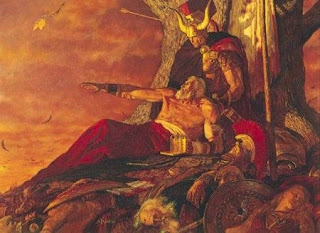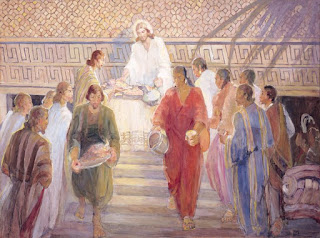Monday, September 11, 2017
REMEMBERING 9/11 ... 1857
Can a community born of faith in the loftiest of ideals, descend into hatred, intolerance, murder and terror? Can a people who embraced a prophetic tradition—who gathered together because they were keenly aware of the injustice, hard heartedness and self-righteousness in the world become so zealous that they move beyond merely embodying the attitudes that they once decried, to embracing barbarism?
The answer is yes, and no people should be more aware of that truth than those belonging to the Mormon religious tradition. Mormonism is, after all, a tradition that originally sprang from the embrace of “The Book of Mormon.” Before the earliest believers had any fully formed explanation of the book’s origins, they had in their hands the book itself. That book told a story that spoke to their experiences and reflected their understanding of human nature and the world in which they lived.
“The Book of Mormon” told the story of two ancient peoples—both descended from a prophet who saw the corruption of the society in which he lived, and fled with his wife and children to a distant land. There, separated from his kinsmen, the prophet hoped that his children and their descendants would live as a free, just, godly and virtuous people. But from the beginning of the story, all of his children engaged in violence, jealously and division.
The prophet’s descendants divided themselves into two distinct civilizations—neither of which were purely just or virtuous, and both of which embraced violence and war when they felt threatened. In each of these two cultures there arose divinely-called prophets and leaders—and in each, there arose charlatans, demagogues, war-mongers and tyrants. For six hundred years, these two cultures not only warred with one another, but were each internally divided ethnically, religiously and politically. Each cultural was blinded by the belief that its enmity with the other was either rationally or divinely justified. Brought to the brink of destruction not only by violence but by catastrophic natural disasters at the time of Jesus’s crucifixion, they were visited by the resurrected Christ who taught them the principles embodied in the Biblical Sermon on the Mount. After six centuries of ethnic division, demagogy, social injustice and war, the two civilizations come together as one people and lived in peace for over a century. The reason for—and the key to—this lasting peace were the pure and simple principles taught by Jesus: love your enemy, pray for those who despitefully use you, turn the other cheek, bless those who curse you, go the extra mile, bear one another's burdens, avoid being sanctimonious.
After a century, prosperity, pride, self-righteousness and contentiousness took root within the people. Ancient grievances were revived, and people divided themselves along ethnic lines. Both descended into barbarism, with one civilization becoming even more sadistic than the other. That civilization—which, through most the story, had the stronger prophetic tradition—was eventually annihilated by the other.
“The Book of Mormon” was cautionary tale for the people who first read it—first and second-generation Americans who were still insecure with the personal liberties their newly formed Republic guaranteed them. These first readers were cautious regarding potential abuses of power by civic as well as ecclesiastical authorities and institutions. They embraced the “pure and simple Gospel of Christ”—which could best be summarized as putting love and charity above all else.
It is one of the supreme ironies in American history, that the largest community of Mormons would, in the 1840s, as a result of persecution and political intrigue, leave the United States, settle in the Rocky Mountains and desert southwest, and there turn inward on itself—instituting an internal “reformation” in which the choice was either unquestioning obedience to ecclesiastical authorities, or punishment—including death (so-called “Blood Atonement”) for blasphemy and apostacy. The theocratic government established in Utah Territory bought its Mormon population in direct conflict with the principles of the United States Constitution. It was soon assumed that military conflict between Utah territorial militias and Federal troops was inevitable.
During this period—in the late summer of 1857—a wagon train made up of Americans primarily from Arkansas and Missouri was making its way to California, through southern Utah. Twenty-five years earlier, Missouri had been the central gathering place for Mormons, but religious persecutions there had ended with a massacre of Mormons at a settlement called Haun’s Mil, and an extermination notice signed by the Governor of Missouri—the only such order ever issued by a U.S. governor against U.S. citizens. The memories of those persecutions and the resentments had only festered among the Mormons seeking to pioneer the harsh desert southwest. The California-bound wagon train wandered into what could now be described as a “perfect storm” for tragedy.
Led by the Mormon Priesthood High Council of Cedar City, Utah, the local militia attacked the wagon train in a spot called Mountain Meadows. After a conflict lasting several days, on September 11, 1857, the wagon train surrendered to the militia after being assured that they would be escorted to safety. Having given up their weapons, the men, women and children of the wagon train formed a long line and, escorted by Mormon militia men, they began to walk out of Mountain Meadows. Suddenly given the signal, each Mormon militia man turned on the man, woman or child nearest him. Within minutes, over 100 men, women and children—aged 8 and older—lay massacred in Mountain Meadows. Their mutilated bodies were left unburied for weeks.
This event—the Mountain Meadows Massacre—was the worst case of domestic terrorism in U.S. history until the Oklahoma City Bombing in 1995. What is so tragic and ironic, is that the perpetrators of the massacre were themselves the victims of earlier religious persecutions and massacre.
Perhaps the greatest irony is that the worst act of domestic terrorism in U.S. history would be perpetrated on September 11, 2001—144 years to the day since the Mountain Meadows Massacre. As with the terrorism of 9/11/1857, the terrorism of 9/11/2001 was perpetrated by religious zealots who clung to memories of and resentments regarding earlier persecutions that their religious communities had suffered.
Reform Mormons embrace 9/11 as a Day of Remembrance. The two terrorist acts that took place on this day—in 2001 and in 1857—are taken as warnings of what can happen when a community clings to grievances of past wrongs, and assumes that they have either a rational or a divinely-mandated license to avenge those wrongs.
Reform Mormons turn to the story told by “The Book of Mormon” for guidance. They realize that no community is immune to bitterness, to fantasies of vengeance for wrongs suffered, and to the intoxicating but deadly illusion that violence against one’s enemies is divinely sanctioned.
On 9/11, Reform Mormons seek to remember that despite wrongs and injustices suffered, they have committed themselves to emulating the character of God as revealed in the character of Jesus. That character is embodied in the principles found in Biblical Sermon on the Mount and in “The Book of Mormon’s” Sermon at the Nephite Temple:
“Behold, it is written, an eye for an eye, and a tooth for a tooth;
but I say unto you, that ye shall not resist evil.
Whosoever shall smite thee on thy right cheek, turn to him the other…
Love your enemies, bless them that curse you,
so good to them that hate you,
and pray for them who despitefully use you and persecute you;
that ye may be the children of your Father who is in heaven;
for He makes his sun to rise on the evil and on the good…
Old things are done away with, and all things have become new.
Therefore, I would that ye should be perfect even as I, or your Father who is in heaven is perfect."
(See III Nephi 12: 38—48 [LDS Edition] / III Nephi 6: 84—92 [COC Authorized Version]






